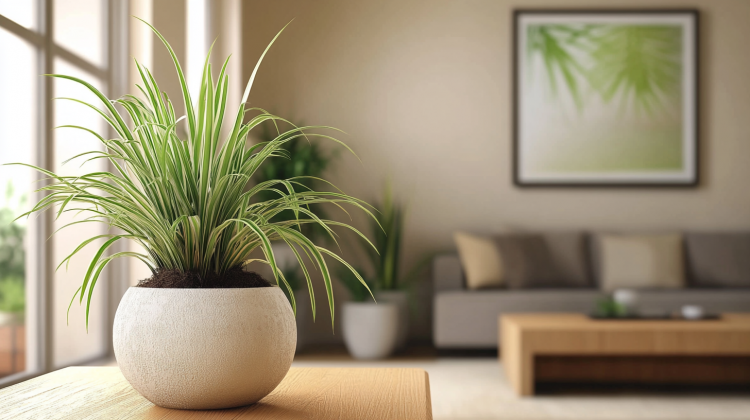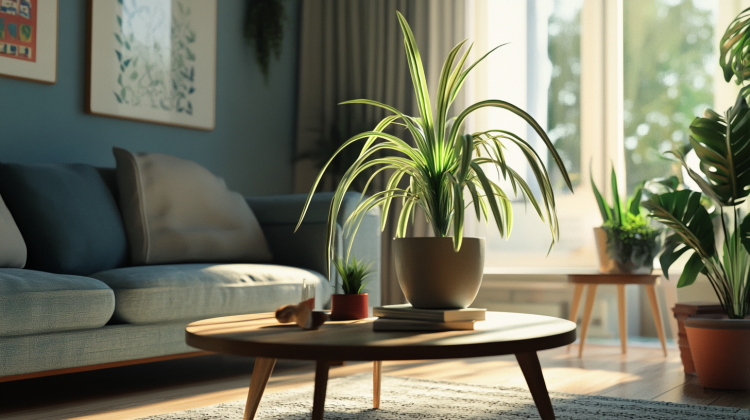
The spider plant (Chlorophytum comosum) is one of the most popular houseplants, known for its resilience, air-purifying qualities, and attractive appearance. With its cascading green and white-striped leaves and charming plantlets, it’s easy to see why spider plants are a favorite among beginners and experienced plant enthusiasts alike. Whether you’re looking to brighten up your home or create a greener indoor space, the spider plant is an excellent choice.
What is a Spider Plant?
The spider plant is a perennial flowering plant native to tropical and southern Africa. Its long, arching leaves and spider-like plantlets (offshoots) give it its name, as these baby plants dangle from the parent plant like spiders on a web. Spider plants are incredibly versatile and thrive both as hanging plants and potted on shelves or tables.
- Scientific Name: Chlorophytum comosum
- Common Names: Spider plant, airplane plant, ribbon plant
- Toxicity: Non-toxic to pets, making it a safe option for homes with cats or dogs.
Why Choose a Spider Plant?
- Low Maintenance: Spider plants are almost impossible to kill. They tolerate neglect, making them ideal for beginners or those with busy schedules.
- Air Purification: NASA studies have shown that spider plants effectively remove toxins like carbon monoxide and formaldehyde from the air, improving indoor air quality.
- Aesthetic Appeal: The variegated foliage and cascading growth pattern make them a beautiful addition to any indoor space.
Caring for a Spider Plant
1. Light Requirements
Spider plants thrive in bright, indirect light but can adapt to low-light conditions. Avoid placing them in direct sunlight, as this can scorch their leaves. A spot near an east- or north-facing window is ideal.
2. Watering
These plants prefer to dry out slightly between waterings. Water your spider plant when the top inch of soil feels dry. Overwatering can lead to root rot, so always ensure the pot has good drainage.
3. Temperature and Humidity
Spider plants prefer temperatures between 60°F and 80°F (16°C to 27°C) and enjoy moderate humidity. They can tolerate occasional temperature drops but should be kept away from drafts and cold windows in winter.
4. Soil and Potting
Use well-draining potting soil to prevent waterlogging. Spider plants grow quickly and may become root-bound, so repot them every 1-2 years to keep them healthy.
5. Fertilizing
Feed your spider plant with a balanced liquid fertilizer every 4-6 weeks during the growing season (spring and summer). Reduce feeding in the fall and winter when growth slows.
Propagating Spider Plants
One of the most exciting aspects of spider plants is how easy they are to propagate. The plantlets, or “spiderettes,” that grow on long stems are ready-made baby plants. To propagate:
- Wait until the plantlet develops small roots.
- Detach the plantlet from the mother plant.
- Plant it in a small pot with fresh soil, or place it in water until the roots grow longer before transferring it to soil.
This process is simple and makes it easy to share spider plants with friends or expand your indoor jungle.
Common Issues and Solutions
1. Brown Leaf Tips
- Cause: Overwatering, low humidity, or excess fluoride in water.
- Solution: Water with distilled or rainwater, increase humidity, and check your watering routine.
2. Pale or Drooping Leaves
- Cause: Insufficient light or underwatering.
- Solution: Move the plant to a brighter location and ensure it’s watered consistently.
3. Root Rot
- Cause: Overwatering or poor drainage.
- Solution: Allow the soil to dry out between waterings and repot in well-draining soil if necessary.
Spider Plants and Your Home
Spider plants are incredibly versatile and work well in a variety of settings:
- Hanging Baskets: Their cascading leaves and plantlets look stunning when allowed to hang freely.
- Shelves and Tables: Compact and tidy, spider plants can fit on desks, bookshelves, or kitchen counters.
- Bathroom Decor: They thrive in humid environments, making them perfect for bathrooms with indirect light.
Fun Facts About Spider Plants
- Spider plants are believed to bring good luck and positive energy, according to feng shui principles.
- They were one of the first plants studied by NASA for their air-purifying abilities.
- Their scientific name, Chlorophytum comosum, translates to “green plant with a tuft,” a fitting description of their growth pattern.
Spider Plants are Great House Plants
Spider plants are a timeless favorite for good reason—they’re easy to care for, visually appealing, and beneficial for indoor air quality. Whether you’re just starting your indoor gardening journey or looking to add a reliable plant to your collection, the spider plant is a perfect choice. With minimal effort, you can enjoy the vibrant greenery and unique charm of this beloved houseplant for years to come.

Here are some creative ways to style spider plants in your home:
1. Hanging Baskets for a Cascading Effect
Spider plants look stunning when placed in hanging baskets, allowing their long, arching leaves and plantlets to cascade naturally. Hang them near a sunny window in your living room, bedroom, or kitchen for an eye-catching display. To add a modern touch, opt for macramé hangers or colorful pots that match your home decor.
2. Create a Green Shelf Display
Combine spider plants with other houseplants to create a lush, layered look on bookshelves or plant stands. Their variegated foliage provides contrast and works well alongside plants with broader or darker leaves, like pothos or philodendrons. Use pots of varying heights and textures to add visual interest.
3. Use Them as Table Centerpieces
Smaller spider plants or newly propagated plantlets can be potted in decorative containers and used as table centerpieces. For special occasions, pair them with candles, small stones, or fairy lights to create a charming, nature-inspired centerpiece for your dining table or coffee table.
4. Bathroom Beautification
Spider plants thrive in humid environments, making them perfect for bathrooms with sufficient indirect light. Place them on a windowsill, countertop, or even on top of a cabinet to add a touch of greenery. Their ability to filter the air adds a refreshing vibe to this often-overlooked space.
5. Create a Plant Wall
Install a series of floating shelves on a blank wall and fill them with spider plants and other cascading houseplants. This is a great way to create a living, green feature wall in your home. Alternatively, use wall-mounted planters designed for smaller plants to make a statement.
6. Propagation Display in Water
Display spider plantlets in clear glass jars or vases filled with water as they grow roots. This doubles as a propagation station and a decorative piece, especially when placed in a sunny spot. Use jars of varying shapes and sizes for a creative look.
7. Cluster with Pet-Friendly Plants
Since spider plants are non-toxic, group them with other pet-friendly plants like calathea, areca palms, or parlor palms. This creates a safe and vibrant plant arrangement that both you and your pets can enjoy.





